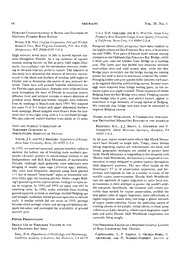
Bridge use by peregrine falcons in the San Francisco Bay area PDF
Preview Bridge use by peregrine falcons in the San Francisco Bay area
68 Abstracts VoL. 28, No. 1 Mercury Concentrations in Blood and Feathers of U.S.A. D.P. Gregoire and B.G. Walton. Santa Cruz Nestling Florida Bald Eagles Predatory BirdResearch Group, Lower Quarry, University Wood, P.B. West Virginia Cooperative Fish and Wildlife ofCalifornia, Santa Cruz, CA 95064 U.S.A. m Research Unit, West Virginia University, P.O. Box 6125, Peregrine falcons (Falco peregrinus) have been resident WV Morgantown, 26506-6125 U.S.A. the highly urbanized San Francisco BayArea at least since the mid 1980s. Two pairs of falcons make annual nesting High mercury levels occur in fish in several aquatic sys- attempts on the Oakland-San Francisco Bay Bridge, while tems throughout Florida. As a top predator of aquatic a third pair uses the Golden Gate Bridge as a hunting systems relying heavily on fish as prey, bald eagles {Hal- post. The latter pair has shifted nest locations between laeetus leucocephalus) can bio-accumulate mercury result- ing in elevated mercury levels in tissues. The objective of near-urban sites and wild coastal sites, while the Bay Bridge pairs invariably use the bridge during the nesting this study is to determine the amount of mercury concen- season but tend to move to downtown areas for the winter trated in the blood and feathers of nestling bald eagles in Foraging habits and prey species differ between each pair, Florida and to determine the source of any mercury de- as do eggshell thinning and hatching success. In most years tected. These data will provide baseline information for eggs were removed from bridge nesting pairs, in one in- the Florida eagle population, Samples were collected from stance a pair was triple clutched. Three instances of chicks nests throughout the state of Florida to examine several fledging from the Bay Bridge were noted. Fledging success different river and wetland systems to assure detection of problem areas. Blood and feather samples were collected from bridge sites is poor, and several factors appear to from 41 nestlings in March and April 1993. We removed cWoentribute to high mortality of young falcons at fledging. % conclude that bridge nest sites must be enhanced to the outer of 5-7 breast and upper abdominal feathers improve fledging success. from nestlings. Blood samples were drawn from the bra- Wcheial vein in the right wing with a 2 cc sterilized syringe. Hawks Aloft Worldwide: A Cooperative Strategy also collected molted feathers from adults at 16 nests. FOR Protecting Migrating Raptors in the Americas Diet and Habitat Utilization of Bildstein, K.L., Brett, L. Goodrich and C J.J. Northern Goshawks in Viverette. Hawk Mountain Sanctuary, Kempton, PA Shrub-Steppe Habitats of Nevada 19529 U.S.A. Younk,J.V. and M.J. Bechard. DepartmentofBiology, In the past, raptor conservation efforts like Hawk Moun- Boise State University Boise, ID 83725 U.S.A. tain’s have focused on single sites. Today, many threats , In 1993, we used tail-mounted, posture-sensitive radios to facing migrating raptors are international, not local, and broad, geographic strategies are needed to protect these monitor the habitat use of breeding male northern gos- hawks {Accipiter gentilis) in shrub-steppe habitats in the birds. Hawk Mountain is responding to this situation with Hawks Aloft Worldwide, the Sanctuary’s cooperative con- Independence and Bull Run Mountains of northeastern servation strategy designed to protect raptors throughout Nevada. Although male goshawks were sometimes seen their migratory journeys. The new effort builds on the foraging in nearby open sage {Artemisia spp.) habitats, Sanctuary’s 57 yr of conservation experience, and for- they were most frequently observed using thick patches malizes and expands its role as a mentor to many of the (<1 ha) of stunted “snowbank” aspen or streamside wil- world’s raptor conservationists. Hawks Aloft Worldwide lows {Salix spp.) for hunting perches. Males caught Beld- uses the spectacle of raptor migration to unite local con- ing’s ground squirrels {Spermophilus beldingi) in open ar- servationists in their attempts to protect the world’s wild- eas by surprise. In 1992 and 1993 we spent over 450 hr life resources. Specifically, the initiative will: collect sci- observing nests. In 1992, males switched from hunting entific data needed for raptor conservation, publish the ground squirrels to birds as nestlings reached fledging age first global atlas of raptor migration, train individuals at and drought conditions forced ground squirrels to estivate A raptor-migration watch sites, and forge a global network early. similar switch did not occur in 1993, perhaps of raptor conservationists. Given the ambitious nature of because above average winter and spring precipitation de- training phases of the project, initial efforts in these areas layed estivation and prolonged the availability of ground will focus on Latin America, where raptor-migration watch squirrel prey. sites and active Hawks Aloft Worldwide cooperators are currently being sought. Poster Presentations Bridge Use by Peregrine Falcons in the The Peregrine Falcon on a Western Coastal Lagoon San Francisco Bay Area AT Baja California Sur, Mexico Bell, D.A. Department ofOrnithology and Mammalogy, Castellanos, A., F. Salinas, A. Ortega-Rubio, C California Academy ofSciences, San Francisco, CA 94118 ArGUELLES, and H. RoMERO-ScHMIDT. Division de
